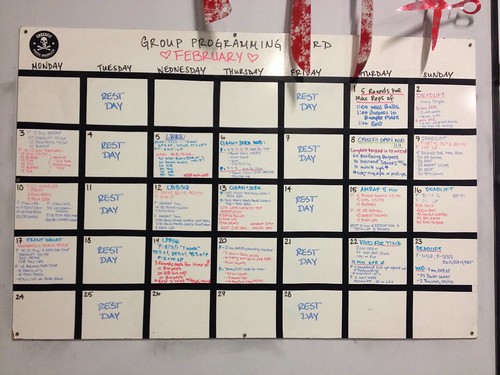
In our popular article "The Benefits of Leveled Programming," we discussed how CFSBK offers two different levels of programming to accommodate the varied needs and goals of our athletes. Fitness programming is a more basic version of the day’s WOD, while Performance caters to our more advanced athletes. Regardless of their differences, both levels of programming happen within a planned eight-week training cycle. In today's article, I’ll discuss this programming template and its benefits.
Beyond the positive training effects of consistent and progressive exposure to lifts and skills, our coaching staff finds that working on a weekly template leverages our ability to teach and reinforce movement patterns in group classes—something any coach working with general population CrossFitters should be interested in. Furthermore, your most inexperienced members will benefit especially from the ability to train specific exercises on a weekly basis for seven to eight weeks. If that same member only practiced clean and jerks when they happened to showed up in a WOD within a randomized programming template (or at a gym without a template), it's likely that their technique and capacity on that movement would progress much more slowly. Ultimately, as affiliate owners and coaches, it should be our goal to teach safe and efficient movement to anyone who happens to walk through our doors. With that in mind, we should bias practices that increase and augment training efficacy and are accessible to a broad range of skill levels.
Overview
CFSBK programs rotating eight-week training cycles, which follow the general template below. This is considered our "Macrocycle":
Training Week 1
Training Week 2
Training Week 3
Training Week 4
Training Week 5
Training Week 6
"Crush Week"
Back Off/Transition Week
 In training weeks one to six, we work off a basic distribution of lifts and skills (which I'll discuss in further detail below). The intention of these weeks is to target particular movements while still biasing general fitness as the overarching goal of training.
In training weeks one to six, we work off a basic distribution of lifts and skills (which I'll discuss in further detail below). The intention of these weeks is to target particular movements while still biasing general fitness as the overarching goal of training.
During Crush Week, we bias longer, higher volume or benchmark workouts and overlap elements that were programmed on particular days. For example, if we were deadlifting the previous six training weeks on Sundays, we might do a workout like "Diane" or "Bradshaw" during Crush Week. Similarly, we might attempt new PRs in lifts during or just before Crush Week—making the assumption that the cycle’s first six weeks of training has led to significant improvements in the fitness and strength of our athletes.
The Back Off/Transition Week biases lower volume workouts and introduces the movements in the next cycle. During this week in group classes, we focus on extended technical reviews of the upcoming lifts for new members, while advanced members focus on establishing opening weights for the cycle.
 Building the Weekly Template
Building the Weekly Template
CFSBK begins building the skeleton of our programming by figuring out which lifts we want to target on which days. This depends on the lifts we've been targeting in the most recent cycles, and keeps in mind that we want to create a balanced distribution of movements over time. Next we'll layer in any skill work we want to work on improving. Once we've established the template, we'll program the details of the Performance and Fitness versions of each lift or skill for the following six weeks. For example, the Fitness programming on back squats might follow a basic linear progression while the Performance programming calls for two 5/3/1 Wendler cycles.
By programming in this way, we know exactly what the lifts will look like for the upcoming six weeks and as coaches, we can make intelligent and informed training recommendations to our members on a daily basis in group classes. The metcons and assistance work are programmed one to two weeks ahead of time and adjusted based on the feedback we're getting from members, and from our coaches who follow the programming. We generally attempt to minimize interference from the metcons or assistance work, prioritizing our target lifts. For example, if we're bench pressing on Monday, Sunday's WOD won't have a ton of push-ups in it.
As a standard for our eight-week cycle, we almost always program in squats twice weekly and hit at least one Olympic lift. Tuesdays and Fridays are always programmed Rest Days. So here is what a week might look like at CFSBK:
Monday:
Low Bar Back Squat
Metcon or Assistance Work
Tuesday
Rest Day
Wednesday:
Handstand Practice (20 minutes)
Metcon
Thursday
Clean and Jerks
Front Squats
DIY cash out if time/space permits
Friday
Rest Day
Saturday:
Metcon
Assistance work if time permits
Sunday:
Bench Press
Metcon or Assistance Work
Check out CFSBK's blog on this day for our latest program (I always post these during Back Off Week).
Rest Days
A common question we get is: What happens on a programmed Rest Day? CFSBK is open on Tuesdays and Fridays, and group classes on those days run split programming, meaning one coach runs the previous day’s workout while another coach simultaneously runs the next day’s workout. This requires foresight and planning, and we make sure to accommodate for available space and equipment when writing out the week.
We've been doing this for years now and have found it to be a very effective system for our population. Our maximal group class membership is 5x per week, so members can easily coordinate their training schedules to work with and around the Rest Days. Some gyms program seven days per week of novel or continuous workouts, which I think can become problematic since it doesn’t emphasize the importance of rest and recovery. I find that the Rest Day split programming is a great way to establish a reasonable work/rest balance and rhythm, while still providing options for your members seven days per week.
 Communicating this Information to Athletes
Communicating this Information to Athletes
Programming based on a template has plenty of utility on its own, but sharing the intention and methodology behind such programming with your athletes substantially increases its benefits, by enabling them to participate more proactively and take ownership of their long-term training goals.
CFSBK starts explaining our programming as soon as athletes graduate from Foundations—though with far less detail than what I’ve described above. We share enough to let them know that they're going to see some consistency in the programming on a weekly basis and thus can expect to focus on certain lifts or movements on particular days. We also encourage them to come to at least one squat day (because at minimum, everyone should be squatting once a week). It can be a lot of information for new athletes to absorb, in addition to learning all the movements, so we write out whatever current template we're using and tell them to simply pay attention, especially to the blog, and we promise that it will all eventually start making sense.
And it does start to make sense. CFSBK’s experienced members appreciate as much information and detail as we’re able to share. To communicate with them, we indicate where we're at in the cycle by writing the designation below the lift on the blog and sharing it during the white board review of each group class. For example, we might write “e1/6,” which means that today is exposure one of six for this movement, further reinforcing that this movement will show up on that day for five more weeks.
Conclusion
Planning out your programming ahead of time and with intention not only increases the efficacy of your coaching staff, but it holds your affiliate more accountable for being professional about how you’re training your athletes. This is especially important when managing the training of several hundred athletes who work out at your affiliate, and confirms that you’re running a professional and organized gym that isn’t “winging it.”
__________________________
How do you organize programming at your affiliate?